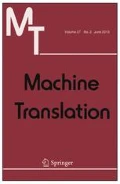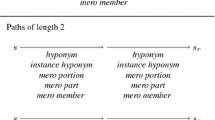Abstract
This paper describes salient aspects of the OntoSem lexicon of English, a lexicon whose semantic descriptions can either be grounded in a language-independent ontology, rely on extra-ontological expressive means, or exploit a combination of the two. The variety of descriptive means, as well as the conceptual complexity of semantic description to begin with, necessitates that OntoSem lexicons be compiled primarily manually. However, once a semantic description is created for a lexeme in one language, it can be reused in others, often with little or no modification. Said differently, the challenge in building a semantic lexicon is describing semantics; once the semantics are described, it is relatively straightforward to connect given meanings to the appropriate head words in other languages. In this paper we provide a brief overview of the OntoSem lexicon and processing environment, orient our approach to lexical semantics among others in the field, and describe in more detail what we mean by the largely language-independent lexicon. Finally, we suggest reasons why our resources might be of interest to the larger community.
Similar content being viewed by others
References
Beale S, Lavoie B, McShane M, Nirenburg S, Korelsky T (2004) Question answering using ontological semantics. In: Proceedings of the ACL-2004 Workshop on Text Meaning and Interpretation, Barcelona, Spain, pp 41–48
Beale S, Nirenburg S, Mahesh K (1995) Semantic analysis in the Mikrokosmos machine translation project. In: Proceedings of the 2nd Symposium on Natural Language Processing, Bangkok, Thailand, pp 297–307
Beale S, Nirenburg S, McShane M (2003) Just-in-time grammar. In: Proceedings of the International Conference on Machine Learning: Models, Technologies and Applications, MLMTA’03, Las Vegas, Nevada, pp 291–297
Butt M, Forst M, Holloway King T, Kuhn J (2003) The feature space in parallel grammar writing. In: A workshop on ideas and strategies for multilingual grammar development, taking place during the fifteenth european summer school for logic, Language and information, Vienna, Austria, pp 9–16
Clark P, Porter B n.d. KM: The Knowledge Machine 2.0: users manual, Available at http://www.cs.utexas.edu/users/mfkb/km.html/userman.pdf [Last access14 Feb 2006]
Crouch D, Holloway King T (2005) Unifying lexical resources. In: Proceedings of the Interdisciplinary Workshop on the Identification and Representation of Verb Features and Verb Classes, Saarbrücken, Germany, pp~32–37
Dorr BJ (1993) Machine translation: a view from the lexicon. The MIT Press, Cambridge, Mass
Dorr BJ (1997) Large-scale dictionary construction for foreign language tutoring and Interlingual Machine translation. Mach Trans 12:271–325
Fass D (1991) met*: A method for discriminating metonymy and metaphor by computer. Comput Linguist 17:49–90
Fass D, Wilks Y (1983) Preference semantics, ill-formedness and metaphor. Amer J Comput Linguist 9:178–187
Fellbaum C (1999) A semantic network of English: The mother of all wordnets. Comput Humanit 32:209–220
Fikes R, Jenkins J, Frank G (2003) JTP: A system architecture and component library for hybrid reasoning. In: Proceedings of the Seventh World Multiconference on Systemics, Cybernetics, and Informatics, Orlando, Florida
Fodor JA (1975) The language of thought. Thomas Crowell, New York
Grosz B, Haas N, Hendrix G, Hobbs J, Martin P, Moore R, Robinson J, Rosenschein S (1982) DIALOGIC: A core natural-language processing system. In: COLING 82: Proceedings of the Ninth International Conference on Computational Linguistics, Prague, Czechoslovakia, pp 95–100
Hirst G (1995) Near-synonymy and the structure of lexical knowledge. In: Representation and acquisition of lexical knowledge: polysemy, ambiguity, and generativity: papers from the 1995 AAAI symposium, Stanford, CA, pp 51–56
Hobbs JR (1985) Ontological promiscuity. In: 23rd annual meeting of the association for computational linguistics, Chicago, Illinois, pp 61–69
Hobbs JR (1986) Overview of the TACITUS project. Finite Str Newslet Comput Linguist 12:220–222
Hobbs JR (1989) World knowledge and word meaning. In: Wilks Y (eds) Theoretical issues in natural language processing, Lawrence. Erlbaum Associates, Hillsdale, NJ, pp 16–21
Hobbs JR, Bear J (1990) Two principles of parse preference. In: COLING-90: Papers presented to the 13th international conference on computational linguistics, Helsinki, Finland, vol 3, pp 162–167
Hobbs JR, Stickel M, Martin M, Edwards D (1990) Interpretation as abduction. In: 26th annual meeting of the association for Computational Linguistics, Buffalo, New York, pp 95–103
Ide N, Véronis J (1993) Extracting knowledge bases from machine-readable dictionaries: Have we wasted our time? In: Proceedings KB&KS’93, International Conference on Building and Sharing of Very Large-Scale Knowledge Bases, Tokyo, Japan, pp 257–266
Jackendoff RS (1983) Semantics and cognition. The MIT Press, Cambridge, Mass
Jackendoff RS (1990) Semantic structures. The MIT Press, Cambridge, Mass
Lenci A, Bel N, Busa F, Calzolari N, Gola E, Monachini M, Ogonowski A, Peters I, Peters W, Ruimy N, Villegas M, Zampolli A (2000a) SIMPLE: a general framework for the development of multilingual lexicons. Int J Lexicogr 13:287–312
Lenci A, Busa F, Ruimy N, Gola E, Monachini M, Calzolari N, Zampolli A, Guimier E, Recourcé G, Humphreys L, Von Rekovsky U, Ogonowski A, McCauley C, Peters W, Peters I, Gaizauskas R, Villegas M (2000b) SIMPLE Work Package 2—Linguistic specifications, Deliverable D2.1, ILC/CNR, Pisa, Italy
Levin B (1995) English verb classes and alternations. University of Chicago Press, Chicago, Illinois
Mahesh K, Nirenburg S, Beale S (1997) If you have it, flaunt it: Using full ontological knowledge for word sense disambiguation. In: Proceedings of the 7th International Conference on Theoretical and Methodological Issues in Machine Translation, Santa Fe, New Mexico, pp 1–9
McShane M, Beale S, Nirenburg S (2004a) Some meaning procedures of ontological semantics. In: LREC 2004: Fourth international conference on language resources and evaluation, Lisbon, Portugal, pp 1885–1888
McShane M, Beale S, Nirenburg S (2004b) OntoSem methods for processing semantic ellipsis. In: Proceedings of HLT/NAACL 2004 Workshop on Computational Lexical Semantics, Boston, Mass, pp 1–8
McShane M, Nirenburg S, Beale S (2005b, in press) Semantics-based resolution of fragments and underspecified structures. To appear in Trait Autom Lang 46.1
McShane M, Nirenburg S, Beale S (forthcoming) Multi-word entities in human- and machine-oriented lexicons. To appear in: Sica G (ed) The dictionary: open problems, Polimetrica, Monza-Milano, Italy
McShane M, Nirenburg S, Beale S, O’Hara T (2005a) Semantically rich human-aided machine annotation. In: Frontiers in corpus annotation II: Pie in the Sky, Workshop at ACL 2005, Ann Arbor, MI, pp 68–75
McShane M, Zabludowski M, Nirenburg S, Beale S (2004c) OntoSem and SIMPLE: two multi-lingual world views. In: Proceedings of ACL-2004 Workshop on Text Meaning and Interpretation, Barcelona, Spain, pp 25–32
Nirenburg, McShane M, Beale S (2004b) The rationale for building resources expressly for NLP. In: LREC 2004: Fourth international conference on language resources and evaluation, Lisbon, Portugal, pp 3–6
Nirenburg S, Raskin V (1999) Supply-side and demand-side lexical semantics. In: Viegas (1999), pp 283–298
Nirenburg S, Raskin V (2001) Ontological semantics, formal ontology, and ambiguity. In: International conference on formal ontology in information systems: FOIS-2001, Ogunquit, Maine, pp 151–161
Nirenburg S, Raskin V (2004) Ontological semantics. MIT Press, Cambridge, Mass
Nirenburg S, Wilks Y (2001) What’s in a symbol: Ontology and the surface of language. J Exp Theor AI 13:9–23
Onyshkevych B (1997) An ontological-semantic framework for text analysis. Ph D. thesis, Center for Machine Translation, Carnegie Mellon University, Pittsburgh, PA
Onyshkevych BA (1999) Categorization of types and applications of LRs. In: Viegas (1999), pp 3–17
Palmer M, Grishman R, Calzolari N, Zampolli A (2000) Standardizing multilingual lexicons. In: Linguistic exploration: workshop on web-based language documentation and description, Philadelphia, PA, pp 265–273
Palmer M, Xue N, Babko-Malaya O, Chen J, Snyder B (2005) A parallel proposition bank II for Chinese and English. In: Proceedings of the Workshop on Frontiers in Corpus Annotation II: Pie in the Sky, Ann Arbor, MI, pp 61–67
Pederson BS, Keson B (1999) SIMPLE – semantic information for multifunctional plurilingual lexica: some examples of Danish concrete nouns. In: SIGLEX99 standardizing lexical resources, College Park, MD, pp 46–51
Pulman SG (1983) Generalised phrase structure grammar, Earley’s algorithm, and the minimisation of recursion. In: Sparck Jones and Wilks (1983), pp 117–131
Pustejovsky J (1995) The generative lexicon. The MIT Press, Cambridge, Mass
Sampson G (1975) The form of language. Weidenfield and Nicholson, London
Schank RC (1972) Conceptual dependency: A theory of natural language understanding. Cogn Psychol 3:532–631
Schank R, Abelson, R (1977) Scripts, plans, goals and understanding. Lawrence Erlbaum, Hillsdale, NJ
Sparck Jones K, Wilks Y (1983) (eds) Automatic natural language parsing. Ellis Horwood, Chichester, England
Viegas E (eds) (1999) Breadth and depth of semantic lexicons. Kluwer Academic Publishers, Dordrecht
Wilks YA (1978) Making preferences more active. Arti Intell 11:197–223
Wilks Y (1985) Does anyone really still believe this kind of thing? In: Sparck Jones and Wilks (1983), pp 182–189
Wilks Y (1992) Form and content in semantics. In: Rosner M, Johnson R (eds) Computational linguistics and formal semantics. Cambridge University Press, Cambridge, England, pp 257–281
Wilks YA, Slator BM, Guthrie LM (1996) Electric words: dictionaries, computers and meaning. The MIT Press, Cambridge Mass
XTAG (2001) XTAG English Grammar: Release 2.24.2001. Available at www.cis.upenn.edu/~xtag/gramrelease.html. [Last accessed 3 Feb 2006]
Author information
Authors and Affiliations
Corresponding author
Rights and permissions
About this article
Cite this article
McShane, M., Nirenburg, S. & Beale, S. An NLP Lexicon as a Largely Language-Independent Resource. Machine Translation 19, 139–173 (2005). https://doi.org/10.1007/s10590-006-9001-y
Received:
Revised:
Published:
Issue Date:
DOI: https://doi.org/10.1007/s10590-006-9001-y




